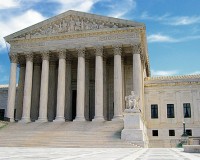
 iStock/Thinkstock(WASHINGTON) — With all eyes on the United States Supreme Court because of President Trump’s announcement of his nominee to fill the seat of the late Justice Antonin Scalia, here are a few facts about the nation’s highest court:
iStock/Thinkstock(WASHINGTON) — With all eyes on the United States Supreme Court because of President Trump’s announcement of his nominee to fill the seat of the late Justice Antonin Scalia, here are a few facts about the nation’s highest court:
How the Supreme Court Came to Existence
Article III of the U.S. Constitution established the Supreme Court and the judicial branch.
While it states that the “judicial power of the United States shall be vested in one supreme Court,” the Constitution didn’t lay out the number of justices on the bench. Congress initially set the number of justices at six — a chief justice and five associate justices.
The number of justices varied over time until Congress passed the Judiciary Act of 1869, which upped the number to the current total of nine — eight associate justices and one chief justice.
Superlatives
Once appointed and confirmed, a Supreme Court justice traditionally serves for life until they step down or die.
“[T]he Judges, both of the supreme and inferior Courts, shall hold their Offices during good Behaviour,” the Constitution states.
The longest serving associate justice was William O. Douglas. Nominated by President Roosevelt, Douglas was confirmed to the Supreme Court in 1939 when he was 40 years old. He served for 36 years, retiring from the court in 1975, when he was 77 years old.
Justice Oliver Wendell Holmes served until he was 90, earning him the title of oldest justice to sit on the Supreme Court.
A justice can also lose his or her spot on the bench if impeached. In 1803, Samuel Chase became the first, and only, justice to be impeached. President Thomas Jefferson suggested that Congress impeach Chase after the associate justice used a grand jury charge to chastise Republicans for repealing the Judiciary Act of 1801. The House impeached Chase, but he was later acquitted by the Senate.
The Firsts
The first ever chief justice was John Jay, nominated by President George Washington and confirmed by the Senate in 1789. The other original justices that made up the first Supreme Court were William Cushing, James Wilson, John Blair, John Rutledge and James Iredell.
The first African American to serve on the Supreme Court was Thurgood Marshall, nominated by President Lyndon B. Johnson.
Nominated by President Ronald Reagan, Sandra Day O’Connor became the first woman to serve on the Supreme Court.
The first Hispanic justice was Sonia Sotomayor, appointed to the bench by President Barack Obama.
The Court Building
From its creation as a government branch, the Supreme Court was without a permanent building of its own for 146 years. During that time, as our nation changed capitals, the Supreme Court used a variety of buildings — the Merchants Exchange Building in New York City, Independence Hall and then later City Hall in Philadelphia, and then the U.S. Capitol in Washington, D.C.
It wasn’t until 1929 that Congress approved the building of a lasting home for the Supreme Court, thanks to the efforts of Chief Justice William Taft, also a former president. Construction started in 1932 and the completed Supreme Court building opened in 1935.
When you walk up to the Supreme Court building on 1 First Street, you’re greeted by two large statues. The statues, sculpted by artist James Earle Fraser, are the Contemplation of Justice, on the left, and the Authority of Law, on the right.
In addition to the courtroom, the building also houses a library and reading room, a dining room for the justices, a basketball court, and a cafeteria that includes a frozen yogurt machine.
Copyright © 2017, ABC Radio. All rights reserved.










